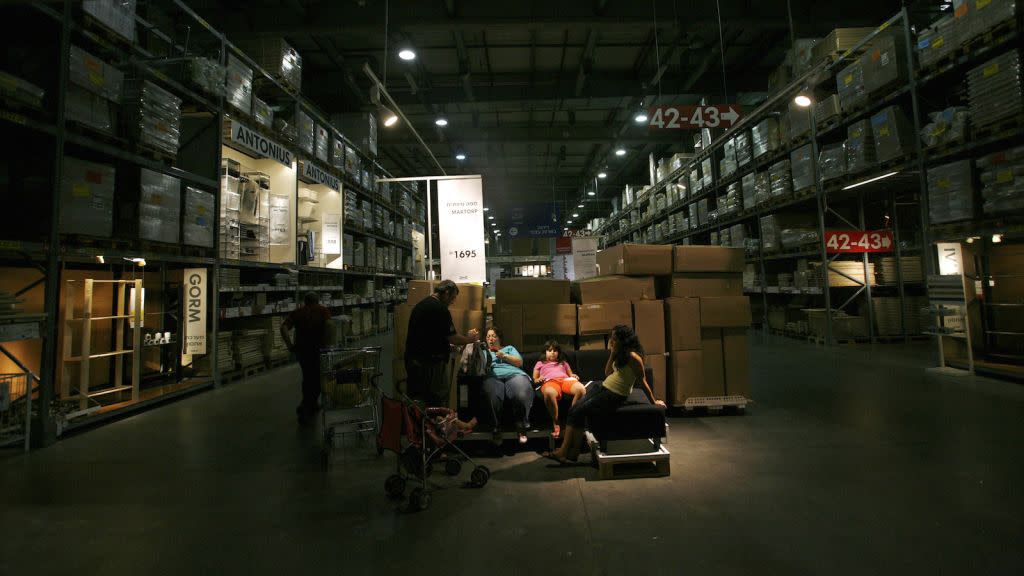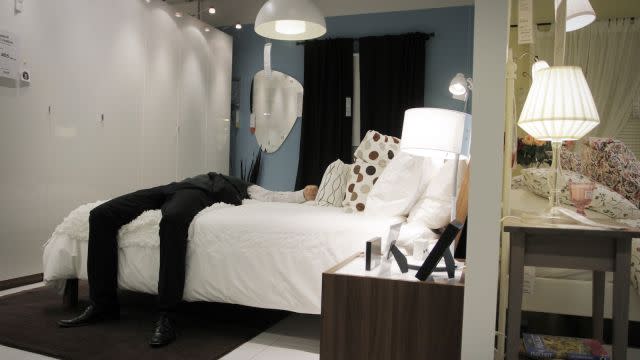We love IKEA because it is the capitalist version of Stockholm Syndrome

Walking into IKEA is an Alice in Wonderland–level vertiginous feeling: down the rabbit hole and into a catacomb of rooms upon rooms. A veritable Disneyland for middle-class living, the IKEA store blends fantasy, the social, and cheap cuisine in a wrap of stark yellow and blue. The meals include, of course, meatballs and mashed potatoes with that fruity pink lingonberry sauce, but also there are ribs, mac-n-cheese, carrot cake, and pudding. This food is comforting. In fact, as warehouse-like as the IKEA experience is, it is strangely comfortable.
First, it is important to appreciate just how big IKEA is. IKEA is the largest consumer of wood in the world, singlehandedly responsible for consuming 1% of the world’s wood supply. As of March 2012, Forbes listed IKEA’s founder Ingvar Kamprad as the fourth wealthiest person in the world (although it is difficult to ascertain the exact figure of wealth because the structure of the company is such that no one call tell just how much of it Mr. Kamprad owns). In 2012, 690 million people visited IKEA stores—that’s double the population of the United States.
The chain came into existence in 1943, when young Ingvar was a mere seventeen. The store moved through a variety of permutations, beginning first as a catalogue business for home goods, opening its first showroom store for furniture in 1953, designing its own inexpensive furniture a few years later, and opening the first warehouse-style store in 1958. Ingvar had opened three IKEA stores before deciding to set up the flagship store in Stockholm at a mesmerizing 45,800 square meters in 1965. By this time, the store had already gained a name for itself for inexpensive home goods and furniture.
In a perfect example of commerce mining the fertile land of culture, the design of the flagship store and its trademark maze-like layout was inspired by an early visit to the Guggenheim Museum in New York City. “We could do exactly the same thing: When we open in Stockholm, we could be just like the Guggenheim—we could construct it so we won’t give them a choice where to go.” So wrote Ingvar. No personal choice, but a journey nonetheless. Ingvar is not a stupid man.
In 2012, 690 million people visited IKEA stores—that’s double the population of the United States. As much as IKEA embodies all things Sweden, Kamprad fled Sweden in the 1970s in protest of its high taxes. The company’s general disdain for paying taxes is one of its more contemporary leanings, and IKEA has consistently maneuvered through tax havens and complicated internal structuring (a large portion of the company is ironically a nonprofit). According to a Huffington Post article, IKEA allegedly managed to cut its UK tax bill in half by sending profits to another country in the form of payments to a sister company.
Low cost with meaning
IKEA’s vision statement reads, “Democratic Design: Low Cost with Meaning.” I will focus on the very last word in this utopic claim: meaning. The construction of meaning is, in fact, the sum total of the IKEA experience, a radical form of three-dimensional (perhaps even four dimensional if one considers the time spent) advertising. It is a space where meaning is produced—and by meaning, I mean the construction of a person’s taste, opinions, dispositions, and ultimately actions. Moving through the space deeply impresses one emotionally, rationally, and through lived experiences.
IKEA’s parking lot is massive, and the warehouse is an overwhelming blue and yellow. By now, even getting to IKEA is a sort of journey. Shuttles and even ferries bring customers from far and wide, setting up amusement-park expectations. When going to IKEA a person knows he will spend a good part of the day there. She has already signed a sort of temporal contract before entering the door.
Upon entering, one first encounters the eating area and the children’s play place called Småland. Småland is named after the village in which Kamprad grew up. In each IKEA store, it provides 60 minutes of free childcare for parents as they shop. Småland typically comes equipped with a ball room, construction sets or puppet theaters, educational kids’ videos, and child-care providers. According to the IKEA website, “Småland is a play area where children can feel Swedish forest atmosphere. While they are playing, you can enjoy your shopping experience knowing your children will be safe and cared for.”

A customer ensnared in IKEA’s comforting embrace.
After dropping off the kids and having a nice cozy meal, parents embark on the circuitous journey of well-lit showrooms. Ingvar’s research trip to Frank Lloyd Wright’s Guggenheim inspired this winding road. While each showroom provides new possible designs for living, including bedrooms, living rooms, children’s rooms, bathrooms, and kitchens, one nevertheless has no choice but to follow the singular, well-demarcated route. The experience is very much like walking through a commercial for better living. Customers lie on the beds, sit at the desks, and lounge on sofas, and whether they do so ironically, sincerely, skeptically, or enthusiastically, they all participate (because how can one not) in an adult version of playing house. Each experience is an opportunity to imagine these neatly presented home furnishings as part of their potential future lives.
Sales people do not wander the floor. Instead, IKEA has service areas that you can approach if you have questions or need assistance. This way, the hypnotic spell of fantasy is never broken. It is a somnambulist drift, or perhaps a sensuous commercial made real.
The maze-like design of IKEA is purposefully meant both to guide the shopper’s steps and to disorient his senses. One becomes lost in the twists and turns of the journey, and apparently such vertigo creates a mental state primed for what is known in the industry as “impulse buying.” The visually tantalizing walking experience provides a lived-in sense of desire. Perusing buckets of affordable stuffed toys and children’s rooms, one harkens back to early childhood memories. In grand kitchens one can dream of a family cooking and sharing a meal together. They are soft memories that make the shopper more amenable to that feeling that retailers are trying to manufacture: whimsy.
Activate
After the whirlwind journey of showrooms, customers are spit out into the marketplace. Descending stairs, they find a row of shopping carts and a familiar array of Swedish-designed household goods. Most customers come to IKEA to buy furniture (thus the showroom experience), but they first encounter aisles upon aisles of bowls, spoons, tumblers, vases, lighting fixtures, and faux plants—the very stuff of impulse buying.
It’s like an elaborate entrance hall to enter into Walmart. Customers must first go through the hypnotic spatialized indoctrination ceremony to prime them up, and then they make their consumer fantasies come to life. It’s not just shopping, but shopping done by a socially prepped and activated customer.
After the market, the customer is then again spit out into the warehouse. What was minutes before a fantasy world of lush showrooms is now a vast warehouse of flat-packed shelves with large bin numbers. The abrupt transition is like peeking behind the curtain. The customer is now in the raw industrial space where packaged goods have been off-loaded from sea containers on giant freighters from China. No longer just a customer, one is sort of a coworker. At this part of the ride, we, the customer, must participate in the construction of that world we initially walked through.
IKEA is a profound combination of utility and comfort. Somewhere between Carhart and pajamas. IKEA is a profound combination of utility and comfort. Somewhere between Carhart and pajamas. If the first image one sees is a kids’ playground, the last thing one sees are cardboard boxes on vast steel shelving units. These shifts in somatic space come with equal shifts in the perception of the experiences themselves. And the last stage of that experience takes place far beyond the walls of IKEA.
As we all know, at IKEA’s at-packed furniture is yet-to-be assembled. The customer hauls the goods onto a at shopping cart to finish the IKEA shopping experience at home. The customer, in finishing the work, not only provides savings for both producer and consumer, but also adds a value that perhaps not even Ingvar could have predicted. The customer, in essence, joins the IKEA team from the comfort of the home. A link of work is made between IKEA manufacturing to the assembly line of the living room. This form of cognitive association has been given the clinical name “The IKEA Effect” in a 2009 research study. “The IKEA theory suggests that when people use their own labor to construct a particular product, they value and love it more than if they didn’t put any effort into building it.”
The IKEA Effect. It has a nice ring to it. It is a kind of relationship building. You share in the creation, and you like the store more. It’s a capitalist Stockholm Syndrome (country of origin connection purely a coincidence). The captured person feels sympathy for their captor. But such is the experience of us emotional beings. We can’t help but establish relationships, connections, and emotional ties with those things we walk among, talk to, work with, and play with.
Brand development and advertising realize that not only do images leave an impression on us, but social and physical interaction do as well—perhaps more profoundly. This insight that people like places where they can play, laugh, be taken care of, and do work is obviously not lost on contemporary corporate culture and is a founding principle of the quasi-Swedish tax-evading corporation known as IKEA.
Adapted from Nato Thompson’s new book Culture as Weapon: The Art of Influence in Everyday Life. Used with permission of Melville House. Copyright © 2017 by Nato Thompson.
Learn how to write for Quartz Ideas. We welcome your comments at ideas@qz.com.

Sign up for the Quartz Daily Brief, our free daily newsletter with the world’s most important and interesting news.
More stories from Quartz:

